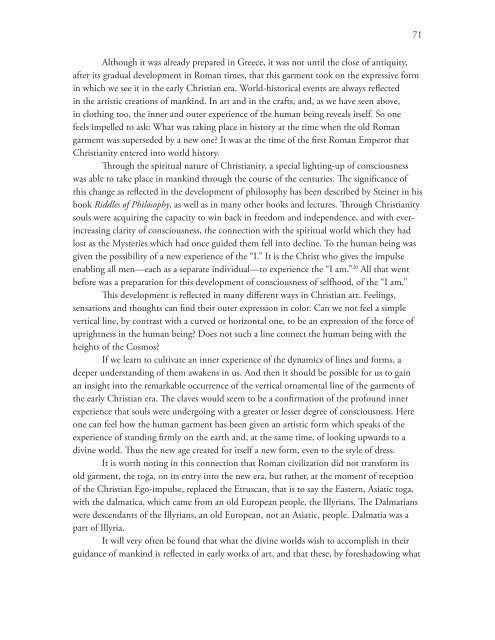Handwork and Handicrafts - Waldorf Research Institute
Handwork and Handicrafts - Waldorf Research Institute
Handwork and Handicrafts - Waldorf Research Institute
You also want an ePaper? Increase the reach of your titles
YUMPU automatically turns print PDFs into web optimized ePapers that Google loves.
Although it was already prepared in Greece, it was not until the close of antiquity,<br />
after its gradual development in Roman times, that this garment took on the expressive form<br />
in which we see it in the early Christian era. World-historical events are always reflected<br />
in the artistic creations of mankind. In art <strong>and</strong> in the crafts, <strong>and</strong>, as we have seen above,<br />
in clothing too, the inner <strong>and</strong> outer experience of the human being reveals itself. So one<br />
feels impelled to ask: What was taking place in history at the time when the old Roman<br />
garment was superseded by a new one? It was at the time of the first Roman Emperor that<br />
Christianity entered into world history.<br />
Through the spiritual nature of Christianity, a special lighting-up of consciousness<br />
was able to take place in mankind through the course of the centuries. The significance of<br />
this change as reflected in the development of philosophy has been described by Steiner in his<br />
book Riddles of Philosophy, as well as in many other books <strong>and</strong> lectures. Through Christianity<br />
souls were acquiring the capacity to win back in freedom <strong>and</strong> independence, <strong>and</strong> with everincreasing<br />
clarity of consciousness, the connection with the spiritual world which they had<br />
lost as the Mysteries which had once guided them fell into decline. To the human being was<br />
given the possibility of a new experience of the “I.” It is the Christ who gives the impulse<br />
enabling all men—each as a separate individual—to experience the “I am.” 20 All that went<br />
before was a preparation for this development of consciousness of selfhood, of the “I am.”<br />
This development is reflected in many different ways in Christian art. Feelings,<br />
sensations <strong>and</strong> thoughts can find their outer expression in color. Can we not feel a simple<br />
vertical line, by contrast with a curved or horizontal one, to be an expression of the force of<br />
uprightness in the human being? Does not such a line connect the human being with the<br />
heights of the Cosmos?<br />
If we learn to cultivate an inner experience of the dynamics of lines <strong>and</strong> forms, a<br />
deeper underst<strong>and</strong>ing of them awakens in us. And then it should be possible for us to gain<br />
an insight into the remarkable occurrence of the vertical ornamental line of the garments of<br />
the early Christian era. The claves would seem to be a confirmation of the profound inner<br />
experience that souls were undergoing with a greater or lesser degree of consciousness. Here<br />
one can feel how the human garment has been given an artistic form which speaks of the<br />
experience of st<strong>and</strong>ing firmly on the earth <strong>and</strong>, at the same time, of looking upwards to a<br />
divine world. Thus the new age created for itself a new form, even to the style of dress.<br />
It is worth noting in this connection that Roman civilization did not transform its<br />
old garment, the toga, on its entry into the new era, but rather, at the moment of reception<br />
of the Christian Ego-impulse, replaced the Etruscan, that is to say the Eastern, Asiatic toga,<br />
with the dalmatica, which came from an old European people, the Illyrians. The Dalmatians<br />
were descendants of the Illyrians, an old European, not an Asiatic, people. Dalmatia was a<br />
part of Illyria.<br />
It will very often be found that what the divine worlds wish to accomplish in their<br />
guidance of mankind is reflected in early works of art, <strong>and</strong> that these, by foreshadowing what<br />
71

















